Pursue decarbonization in all corporate activities
- Challenges
- Our policy
- Responsible executive (as of April 2024)
- Organizational responsibilities (as of April 2024)
- Grievance mechanism
- Main resources for promoting activities (2023)
- Responding to climate change risks and opportunities (TCFD)
- Reducing GHG emissions
- Reducing Greenhouse Gas Emissions
- Increasing use of clean energy
Challenges
- Responding to climate change risks and opportunities (TCFD)
- Reducing greenhouse gas emissions
- Increasing use of clean energy
Relevant stakeholders
- Direct: Local communities, the environment, customers
- Indirect: Shareholders and investors, creditors, NGOs, industry groups
Our policy
Climate change has begun to cause frequent extreme weather events and natural disasters in recent years, such as heavy rainfall and flooding. We acknowledge that it is increasing the risks faced by our Group, including impacts on the growth of trees providing the natural rubber used to make tires, impacts on plant operations, and disruptions in the supply chain.
We also recognize that our Group’s efforts to reduce CO₂ and other greenhouse gas (GHG) emissions within its business are essential in working toward achieving both the Paris Agreement goal of limiting average temperature increases to below 2°C, and carbon neutrality in Japan.
As the impact of climate change intensifies, increasing social demands are being made towards mobility. We see the mobility business as the heart of our Group, and recognize that responding to climate change is the most key issue decisive to our growth. Our responsibility to both current and future generations is to reduce our greenhouse gas (GHG) emissions to help achieve the long-term targets set by the Paris Agreement, as well as expand our use of clean energy, and we are aiming to be carbon neutral by 2050.
With all this in mind, the Group has declared our support for the TCFD recommendations, and will report information covering governance, strategy, risk management, and metrics and targets in accordance with the TCFD framework in order to activate stakeholder dialogue and promote climate change-related initiatives that help work toward a more sustainable world.
The Group supports laws and regulations (such as the Act on Promotion of Global Warming Countermeasures, and the Act on Rationalizing Energy Use) as well as policies related to climate change and reduced energy use, and is taking appropriate steps to comply with them at our sites both in Japan and overseas.
Responsible executive (as of April 2024)
Corporate Officer and Vice president of Quality Assurance, Environment & Safety Headquarters
Organizational responsibilities (as of April 2024)
The Sustainability Committee is chaired by the President and meets quarterly to report on, deliberate and decide on measures and responses to climate change and other sustainability issues.
Under the jurisdiction of the Sustainability Committee, in July 2021 we established the Decarbonization Task Force, led by the officer in charge of Quality Assurance, Environment & Safety Headquarters, to discuss project plans, targets and KPIs for reducing CO₂ emissions in our corporate activities. The Sustainability Committee regularly checks and monitors the task force’s progress.
Climate change-related issues deliberated and decided upon by the Sustainability Committee are reported to the Executive Committee for further consideration, and reflected in the establishment and review of annual and medium-term business plans. These issues are also reported to the Board of Directors in a timely and appropriate manner.
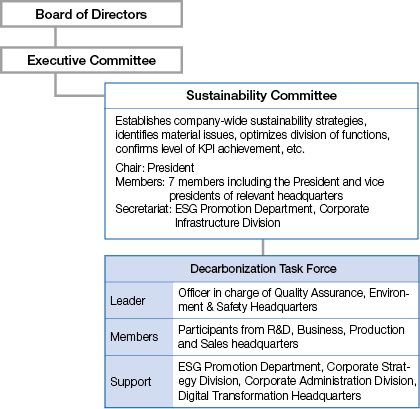
Grievance mechanism
- Reporting hotline (whistle-blowing system): For executives, employees and suppliers
- Customer Relations Department: For customers (consumers) and local communities
- Online inquiry form: For customers (consumers), shareholders and investors, and NGOs
Main resources for promoting activities (2023)
Costs of climate change adaptation and mitigation in main business area: 3,252 million yen
Responding to climate change risks and opportunities (TCFD)
Strategy
We have performed a scenario analysis of the impact climate change could potentially have on Group corporate activities.
Below is an overview of this process.
- Select scenarios to use and understand the outlook of each scenario
- Investigate risks and opportunities in each scenario
- Assess the significance of each risk and opportunity, and identify those of high significance
- Calculate the financial impact of risks expected to have a large medium- to long-term impact and explore possible countermeasures
Scenario analysis process

1. Select scenarios to use and understand the outlook of each scenario
In our analysis, we evaluated the impact of climate-related risks and opportunities in a baseline scenario (3-4°C scenario) and a transition scenario (1.5°C scenario).
In the baseline scenario we focused on physical risks, and explored transition risks in the transition scenario.
| Baseline scenario | Transition scenario | |
|---|---|---|
| Summary | No additional measures are taken to limit the rise of emissions, and average temperatures rise by up to 3-4°C within the 21st century | Decarbonization efforts advance in order to limit the average temperature rise to below 1.5°C during the 21st century |
| Scenario outlook |
|
|
| Primary scenarios referenced |
|
|
2. Investigate risks and opportunities 3. Assess significance
We identified our key climate-related risks and opportunities for each scenario based on the results of a significance assessment.
The significance of individual risks and opportunities was rated by working out the financial impact of each one on our Group business, the probability that the potential main causes of each will occur, and the level of impact—including hypothetical cost—each might have on our business.
We then selected the risks and opportunities in each scenario found to be of high significance, and identified topics that would have a large impact on our business.
Baseline scenario: Risk (medium-term) significance assessment
The red box below indicates risks designated as highly significant.
(Medium-term: around 2030)
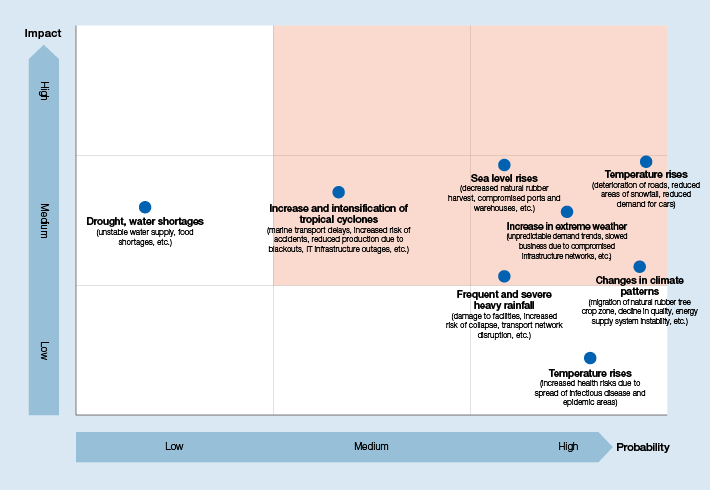
Baseline scenario: Opportunity (medium-term) significance assessment
The red box below indicates risks designated as highly significant.
(Medium-term: around 2030)
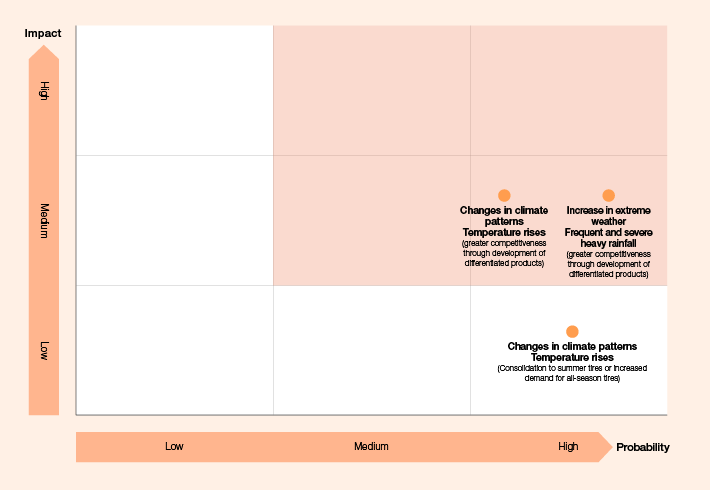
Transition scenario: Risk (medium-term) significance assessment
The red box below indicates risks designated as highly significant.
(Medium-term: around 2030)
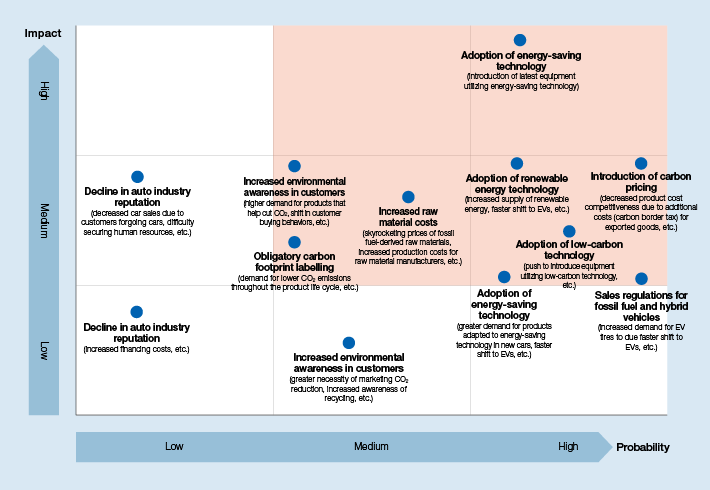
Transition scenario: Opportunity (medium-term) significance assessment
The red box below indicates risks designated as highly significant.
(Medium-term: around 2030)
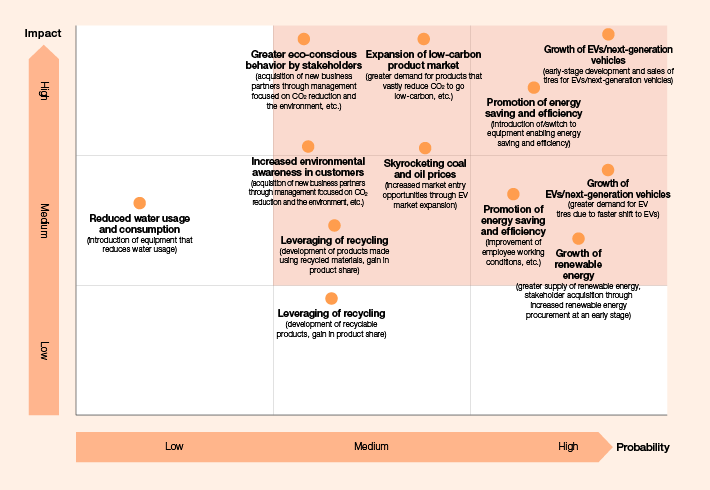
Highly significant risks and opportunities
Baseline scenario Short-term: around 2025, Medium-term: around 2030, Long-term: around 2050
| Category | Type | Climate-related event | Impact on business | Main financial impact | Significance |
|---|---|---|---|---|---|
| Risk | Chronic | Changes in climate patterns Medium to long term |
|
|
Medium to high |
| Temperature rises Medium to long term |
|
|
Medium to high | ||
| Sea level rises Medium to long term |
|
|
Medium to high | ||
| Acute | Increase in extreme weather Medium to long term |
|
|
Medium | |
|
|
Medium to high | |||
| Frequent and severe heavy rainfall Medium to long term |
|
|
Medium to high | ||
|
|
Medium | |||
| Increase and intensification of tropical cyclones Medium to long term |
|
|
Medium to high | ||
|
|
Medium |
| Category | Type | Changes in economy and society | Impact on business | Main financial impact | Significance |
|---|---|---|---|---|---|
| Opportunity | Chronic | Changes in climate patterns, temperature rises Medium to long term |
Greater competitiveness (increased share) through development of differentiated products (high durability, etc.) | Increased profits (increased sales volume) | High |
| Increase in extreme weather, frequent and severe heavy rainfall Medium to long term |
Greater competitiveness (increased share) through development of differentiated products (wet-grip performance) | Increased profits (increased sales volume) | High |
Transition Scenario Short-term: around 2025, Medium-term: around 2030, Long-term: around 2050
| Category | Type | Climate-related event | Impact on business | Main financial impact | Significance |
|---|---|---|---|---|---|
| Risk | Policy | Introduction of carbon pricing Medium to long term |
|
|
High |
|
|
Medium | |||
| Sales regulations for fossil fuel vehicles and HEVs Short to long term |
|
|
Medium | ||
| Obligatory carbon footprint labelling Medium to long term |
|
|
Medium | ||
| Technology | Adoption of renewable energy technology Medium to long term |
|
|
Medium | Adoption of energy-saving technology Short to long term |
|
|
Medium |
| Adoption of low-carbon technology Medium to long term |
|
|
Medium | ||
| Market/ reputation |
Increased environmental awareness in customers Medium to long term |
|
|
Medium | |
| Increased raw material costs Medium to long term |
|
|
Medium to high | ||
|
|
Medium | |||
| Category | Type | Changes in economy and society | Impact on business | Main financial impact | Significance |
|---|---|---|---|---|---|
| Opportunity | Market | Greater eco-conscious behavior by stakeholders Medium to long term |
|
|
High |
| Expansion of low-carbon product market Medium to long term |
|
|
High | ||
| Products/ services |
Increased environmental awareness in customers Medium to long term |
|
|
High | |
| Growth of EVs/next-generation vehicles Medium to long term |
|
|
Medium to high | ||
| Resource efficiency |
Promotion of energy saving and efficiency Medium to long term |
|
|
Medium | |
| Leveraging of recycling Medium to long term |
|
|
Medium | ||
| Reducing water usage and consumption Medium to long term |
|
|
Medium | ||
| Energy | Growth of renewable energy Medium to long term |
|
|
Medium | |
|
|
Medium | |||
| Skyrocketing coal and oil prices Medium to long term |
|
|
High |
4. Calculate financial impact and explore countermeasures
We calculated the financial impact of any risks that are expected to have a significant impact over the medium to long term, and examined possible countermeasures.
1. Impact of changes in climate patterns on the procurement of natural rubber (risk)
| Type | Climate-related event/ financial impact on business |
Impact cost/ year impacted |
Calculation method | Response measures |
|---|---|---|---|---|
| Chronic | Changes in weather patterns cause a shift in the area where natural rubber trees can grow, lower the quality of materials and have other impacts that result in an increase in the cost of natural rubber procurement. |
Approx. 700 million - 9.7 billion yen (Medium-term: 2030) |
(Lower limit) Amount of natural rubber procured × Increase in natural rubber price
Increase in natural rubber procurement costs × Increase in natural rubber procurement
|
|
- *GPSNR: Global Platform for Sustainable Natural Rubber
2. Impact of carbon pricing mechanism(risk)
| Type | Climate-related event/ financial impact on business |
Impact cost/ year impacted |
Calculation method | Response measures |
|---|---|---|---|---|
| Policy | Introducing a carbon pricing mechanism results in a rise in the cost of emitting CO₂. |
Approx. 500 million yen (Medium-term: 2030) |
Unmet CO₂ reduction target × Carbon tax
|
|
| Approx. 5.7 billion yen (Medium-term: 2030) |
|
Risk management
Identification and assessment of climate-related risks is carried out primarily by the Corporate Administration Division, which leads TCFD response, the Corporate Infrastructure Division’s ESG Promotion Department, which oversees the Sustainability Committee, and the Environment & Safety Division’s Environment & Health Department, which manages the Decarbonization Task Force. After assessment, they are deliberated by the Sustainability Committee to evaluate company-wide climate-related risks.
Through the Sustainability Committee’s Decarbonization Task Force, we closely monitor the regulatory requirements in each country—such as GHG emissions reduction targets (including renewable energy targets), vehicle fuel efficiency regulations, and bans on sales of new gasoline-powered vehicles—and encourage the relevant departments to address each risk and manage progress.
Metrics and targets
Climate-related metrics
- • GHG emissions (Scope 1,2,3)
→See the results from 2019-2023 here - • GHG emissions intensity
→See the results from 2019-2023 here -
• Introduction of an internal carbon pricing system
Used to evaluate decarbonization-related projects and other investment initiatives. Following a trial operation in fiscal 2023, the system was officially launched in fiscal 2024 with a set carbon price* of 10,000 yen/ton.
*The appropriateness of the carbon price will be assessed each year and revised if necessary.
Climate-related targets
- • GHG emissions reduction targets
- * Set by the Sustainability Committee in November 2021 and approved by the Executive Committee in December.
- * Announced in February 15 in 2022.
| Scope1,2 | GHG emissions: Reduce GHG emission by 46% by 2030 compared to 2019 and aim to achieve carbon neutrality by 2050. |
| Scope3 | GHG emission per unit: Aim to help reduce GHG emissions per tire in 2030 by 20% compared to 2019. |
- * One of our milestones is to aim to reduce Scope 1 & 2 GHG emissions by 25% by 2025 compared to fiscal 2019
Continuing to Align with TCFD
To continue incorporating the TCFD recommendations, in the future we will further refine our scenario analysis to gain a greater understanding of the quantitative impacts of risks and opportunities, and to investigate, devise and enact strategies in response.
We will also follow the TCFD recommendations when providing our stakeholders with timely disclosures.
Reducing GHG emissions
Reducing energy consumption
To help mitigate climate change, the Toyo Tire Group is striving to reduce energy consumption through effective usage of the energy required for corporate activities both in and outside the organization. We are also developing new products and technologies that contribute to climate change mitigation and adaptation.
See the results from 2019-2023 here
Energy consumption (during logistics)
See the results from 2019-2023 here
Energy intensity
See the results from 2019-2023 here
Examples of reducing energy consumption
- Improved energy efficiency by repairing pipelines and installing high-efficiency equipment
- Improved energy consumption efficiency by transitioning to other energy sources
- Reduced energy consumption by improving use of air conditioning and lighting
We reduced CO₂ emissions from the Sendai Plant by 250 tons per year by enhancing the insulation of the plant’s vulcanizers and pipelines from July 2023.
Reducing the energy requirements of products (fuel-efficient tires)
See the results from 2019-2023 here
Reducing Greenhouse Gas Emissions
Reducing Greenhouse Gas Emissions
Greenhouse gas emissions are seen as a major cause of climate change so the Toyo Tire Group is working to reduce GHG emissions through its products and business activities inside and outside the organization.
The amount of energy consumed increases in line with increases in production volume. However, as a means of addressing Scope 1 and 2 emissions, we are seeking to reduce energy consumption by repairing process pipelines and introducing highly efficient equipment to improve energy efficiency, and also by encouraging automation and improving the usage of air-conditioning and lighting. In addition, we are switching to fuels that emit lower greenhouse gases. We are promoting the use of electric forklifts starting with our plants in Japan. We have purchased electricity derived from renewable sources at Japanese plants and promoted the electrification of 17 forklifts in fiscal 2023, which resulted in a reduction in CO₂ emissions of 421 tons. We will continue to promote electrification. Meanwhile, at the Kuwana Plant, we reduced CO₂ emissions by 364 tons by switching the boiler fuel from A-grade crude oil to natural gas.
The Toyo Tire Group aims to contribute to a 20% reduction in Scope 3 GHG emissions per tire by 2030 compared to 2019. A calculation of GHG emissions throughout the Group’s value chain based on the Japan Automobile Tyre Manufacturers Association’s (JATMA) Tyre LCCO₂ Calculation Guidelines Ver. 3.0.1 revealed that emissions from the Category 11 product use phase account for at least 80% of overall GHG emitted. According to the guidelines, fuel-efficient tires can reduce CO₂ emissions during use (during vehicle driving) by 95.4 kg CO₂e per tire for passenger car radial (PCR) and 879.0 kg CO₂e per tire for truck and bus radial (TBR) compared to standard tires. Our technical division is working to develop technologies to enhance fuel efficiency of tires by reducing their rolling resistance and weight. Over the medium to long term, the Group is planning to enlist the help of the Product Planning Division in upgrading fuel efficiency performance each time we change a tire model. As of 2023, emissions from PCR had been reduced by 1.5% compared to 2019, which is a reduction of 94.8 thousand tons-CO₂e.
GHG emissions
See the results from 2019-2023 here
GHG emissions intensity (t-CO₂/million yen)
See the results from 2019-2023 here
Third-party assurance:
To ensure the accuracy and reliability of the data that we disclose, we have obtained the assurance of a third-party organization for our fiscal 2023 environmental data.
- Verification of scope: 114 sites* of Toyo Tire Corporation and its affiliated companies for total Scope 1 energy-derived CO₂ emissions, Scope 2 emissions, total water intake, breakdown of water intake, total water discharge and breakdown of water discharge
- Verification period: January 2023 to December 2023
- Verification criteria: ISO14064-3: 2006, related laws and regulations, and the assurance organization’s protocol
- Third-party assurance organization: SGS Japan Inc.
- * Toyo Tire Corporation (Headquarters, Sendai Plant, Kuwana Plants (tire and automotive parts), Hyogo Manufacturing Complex, Corporate Technology Center, Tire Technical Center, Automotive Parts Technical Center, Miyazaki Tire Proving Ground, Saroma Tire Proving Ground, Tokyo Office, Hiroshima Office, Kanto Distribution Center, Kansai Distribution Center); Fukushima Rubber Co., Ltd.; Ayabe Toyo Rubber Co., Ltd.; Orient Machinery Co., Ltd. (Headquarters, Sendai branch, Rokko branch); Toyo Tire Japan Co., Ltd. (87 sites); Toyo Automotive Parts (USA), Inc.; Toyo Tire North America Manufacturing Inc.; Toyo Automotive Parts (Guangzhou) Co., Ltd.; Toyo Tire (Zhangjiagang) Co., Ltd.; Toyo Tire (Zhangjiagang) Co., Ltd.; Toyo Tyre Malaysia Sdn. Bhd.; Toyo Rubber Chemical Products (Thailand) Limited; Toyo Tire Serbia D.O.O
Please click here to read more about verification statement.
Increasing use of clean energy
From the second half of 2022, the Toyo Tire Group began switching electricity purchased primarily at production sites to power derived from renewable sources. By the end of 2023, 100% of the electricity purchased at the Sendai Plant, the Kuwana Plant and our tire plant in the United States had been converted to renewables, along with our administrative and technical bases in Japan. We will systematically promote efforts to achieve a global 90% renewable energy usage ratio by 2030. That ratio stood at 71.14% at the end of 2023. We are also actively introducing photovoltaic (PV) power generation systems for in-house use. The largest PV power generation system in Serbia (power generation capacity: 8.4 MW) was installed on the premises of our Serbia Factory, which launched operations in 2022. The system’s annual generation of 10.15 GWh of electricity is helping reduce CO₂ emission by 7,100 tons a year. In 2023, we installed a large-scale PV power generation system with a capacity of 14.0 MW on a factory building’s 96,000 square meter rooftop space in our tire plant in Malaysia. The system is expected to generate 19,000MWh and reduce CO₂ emissions by approximately 12,000 tons per year. Meanwhile in Japan, at the end of 2023, we introduced a solar power generation system at our Corporate Technology Center. The system generates approximately 419,000 kWh each year, which is more than any other system at any other base in Japan, and is equivalent to approximately 12% of the electricity used at the Center. The system is expected to reduce CO₂ emissions by approximately 128 tons per year.
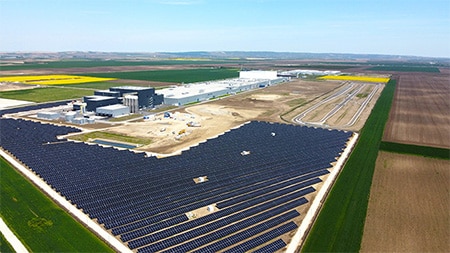
Photovoltaic power generation system installed at our tire plant in Serbia
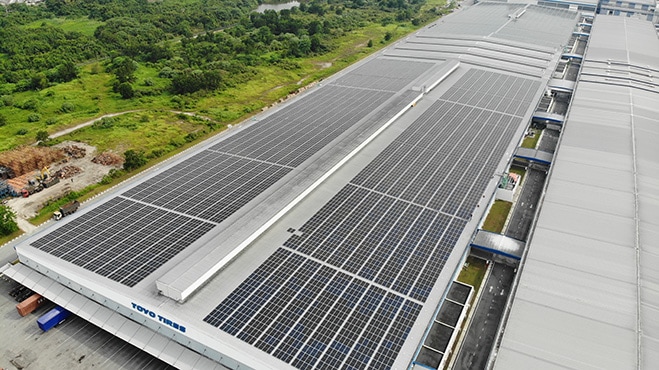
Our Malaysia factory
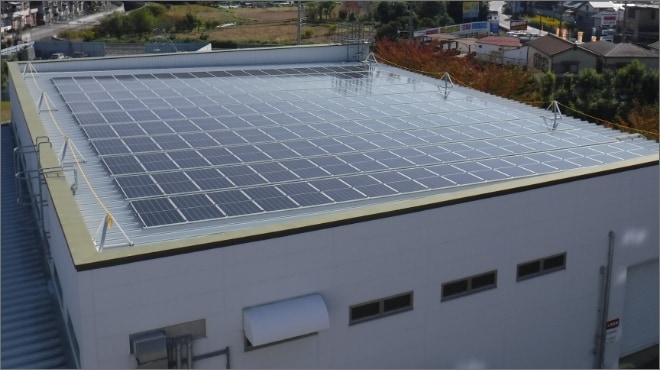
Solar panels introduced at Corporate Technology Center
SBTi*1 initiatives
In November 2024, Toyo Tire Corporation received SBT certification from the Science Based Targets Initiative (SBTi) for its GHG emissions reduction targets set for 2030, which are based on scientific evidence to limit global warming to within 1.5℃.
We have already set targets for reducing GHG emissions as the Toyo Tire Group and are currently working to achieve them, and we will further strengthen and promote our efforts across the entire supply chain.
GHG emissions reduction targets have been certified are as follows.
| Classification | Target |
| Scope1、Scope2 (Emissions from our company's business activities) |
46.20% reduction in total emissions by 2030 (compared to 2019) |
| Scope3 Category 1 (Emissions from other companies in purchased products and services) |
89.00% of suppliers will have science-based targets by 2029 (compared to 2019) |
- *1 SBTi: Initiative to achieve the target of limiting global average temperatures increase to within 1.5℃.
Sustainability
- Message from the President
- TOYO TIRE Value creation
- TOYO TIRE Sustainability
-
TOYO TIRE Materiality
- Help create a society of sustainable mobility / Support the enjoyment of mobility for all
- Support diverse talent with motivating challenges and job satisfaction
- Continue innovating next-generation mobility technology
- Pursue decarbonization in all corporate activities
- Promote supply chain sustainability
- Ensure the fundamentals of manufacturing: quality and safety
-
ESG Activities
- E: Environment
- S: Upholding human rights
- S: Managing occupational health and safety to global standards
- S: Crisis management (responding resiliently to natural disasters, infections and other crises)
- S: Working with local communities (Helping solve local issues)
- G: Sound governance
- G: Compliance
- G: Risk management
- G: Information security
- G: Promoting digital transformation (borderless and centralized business management through ERP reform)
- External Recognition
- Report Library
- ESG Data
- ESG Data/Survey Index
- GRI Content Index
- Communication on Progress (CoP) Index
- Editorial Policy
